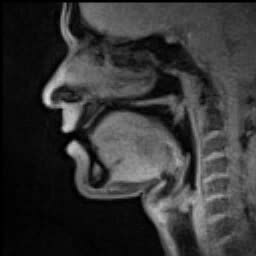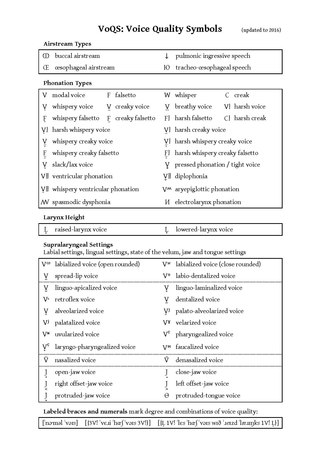Phonetics is a branch of linguistics that studies how humans produce and perceive sounds, or in the case of sign languages, the equivalent aspects of sign. Linguists who specialize in studying the physical properties of speech are phoneticians. The field of phonetics is traditionally divided into three sub-disciplines based on the research questions involved such as how humans plan and execute movements to produce speech, how various movements affect the properties of the resulting sound, or how humans convert sound waves to linguistic information. Traditionally, the minimal linguistic unit of phonetics is the phone—a speech sound in a language which differs from the phonological unit of phoneme; the phoneme is an abstract categorization of phones, and it is also defined as the smallest unit that discerns meaning between sounds in any given language.

In articulatory phonetics, the place of articulation of a consonant is a location along the vocal tract where its production occurs. It is a point where a constriction is made between an active and a passive articulator. Active articulators are organs capable of voluntary movement which create the constriction, while passive articulators are so called because they are normally fixed and are the parts with which an active articulator makes contact. Along with the manner of articulation and phonation, the place of articulation gives the consonant its distinctive sound.
The term phonation has slightly different meanings depending on the subfield of phonetics. Among some phoneticians, phonation is the process by which the vocal folds produce certain sounds through quasi-periodic vibration. This is the definition used among those who study laryngeal anatomy and physiology and speech production in general. Phoneticians in other subfields, such as linguistic phonetics, call this process voicing, and use the term phonation to refer to any oscillatory state of any part of the larynx that modifies the airstream, of which voicing is just one example. Voiceless and supra-glottal phonations are included under this definition.
The field of articulatory phonetics is a subfield of phonetics that studies articulation and ways that humans produce speech. Articulatory phoneticians explain how humans produce speech sounds via the interaction of different physiological structures. Generally, articulatory phonetics is concerned with the transformation of aerodynamic energy into acoustic energy. Aerodynamic energy refers to the airflow through the vocal tract. Its potential form is air pressure; its kinetic form is the actual dynamic airflow. Acoustic energy is variation in the air pressure that can be represented as sound waves, which are then perceived by the human auditory system as sound.

The voiced glottal fricative, sometimes called breathy-voiced glottal transition, is a type of sound used in some spoken languages which patterns like a fricative or approximant consonant phonologically, but often lacks the usual phonetic characteristics of a consonant. The symbol in the International Phonetic Alphabet that represents this sound is ⟨ɦ⟩, and the equivalent X-SAMPA symbol is h\.

The voiced uvular plosive or stop is a type of consonantal sound, used in some spoken languages. The symbol in the International Phonetic Alphabet that represents this sound is ⟨ɢ⟩, a small capital version of the Latin letter g, and the equivalent X-SAMPA symbol is G\.

The voiced velar implosive is a type of consonantal sound, used in some spoken languages. The symbol in the International Phonetic Alphabet that represents this sound is ⟨ɠ ⟩, and the equivalent X-SAMPA symbol is g_<. It is familiar to English speakers as the sound made when mimicking the 'gulping' of water.
In phonetics, the airstream mechanism is the method by which airflow is created in the vocal tract. Along with phonation and articulation, it is one of three main components of speech production. The airstream mechanism is mandatory for most sound production and constitutes the first part of this process, which is called initiation.

A pharyngeal consonant is a consonant that is articulated primarily in the pharynx. Some phoneticians distinguish upper pharyngeal consonants, or "high" pharyngeals, pronounced by retracting the root of the tongue in the mid to upper pharynx, from (ary)epiglottal consonants, or "low" pharyngeals, which are articulated with the aryepiglottic folds against the epiglottis at the entrance of the larynx, as well as from epiglotto-pharyngeal consonants, with both movements being combined.
Esophageal speech, also known as esophageal voice, is an airstream mechanism for speech that involves oscillation of the esophagus. This contrasts with traditional laryngeal speech, which involves oscillation of the vocal folds. In esophageal speech, pressurized air is injected into the upper esophagus and then released in a controlled manner to create the airstream necessary for speech. Esophageal speech is a learned skill that requires speech training and much practice. On average it takes 6 months to a year to learn this form of speech. Because of the high level of difficulty in learning esophageal speech, some patients are unable to master the skill.
Implosive consonants are a group of stop consonants with a mixed glottalic ingressive and pulmonic egressive airstream mechanism. That is, the airstream is controlled by moving the glottis downward in addition to expelling air from the lungs. Therefore, unlike the purely glottalic ejective consonants, implosives can be modified by phonation. Contrastive implosives are found in approximately 13% of the world's languages.

Speech is a human vocal communication using language. Each language uses phonetic combinations of vowel and consonant sounds that form the sound of its words, and using those words in their semantic character as words in the lexicon of a language according to the syntactic constraints that govern lexical words' function in a sentence. In speaking, speakers perform many different intentional speech acts, e.g., informing, declaring, asking, persuading, directing, and can use enunciation, intonation, degrees of loudness, tempo, and other non-representational or paralinguistic aspects of vocalization to convey meaning. In their speech, speakers also unintentionally communicate many aspects of their social position such as sex, age, place of origin, physical states, psychological states, physico-psychological states, education or experience, and the like.
Laryngeal consonants are consonants with their primary articulation in the larynx. The laryngeal consonants comprise the pharyngeal consonants, the glottal consonants, and for some languages uvular consonants.
Faucalized voice, also called hollow voice or yawny voice, is a vocal quality of speech production characterized by the vertical expansion of the pharyngeal cavity due to the lowering of the larynx. It is termed faucalized because of the stretching of the fauces and visible narrowing of the faucial pillars in the back of the oral cavity. During faucalized voice, the sides of pharynx expand outward and the larynx descends and tilts forward. The term "yawny voice" is appropriate to compare this voice quality to the physiological act of yawning. Its opposite is harsh voice, a vocal quality produced when the pharynx is contracted and the larynx raised. Faucalized voice is not to be confused with breathy voice, which involves relaxed vocal folds, greater velocity of airflow through the glottis and produces a lower pitch sound. Faucalized voice involves the forward tilting of the larynx which stretches the vocal folds and produces a higher pitch sound, despite the increased volume of the pharyngeal cavity.
Speech production is the process by which thoughts are translated into speech. This includes the selection of words, the organization of relevant grammatical forms, and then the articulation of the resulting sounds by the motor system using the vocal apparatus. Speech production can be spontaneous such as when a person creates the words of a conversation, reactive such as when they name a picture or read aloud a written word, or imitative, such as in speech repetition. Speech production is not the same as language production since language can also be produced manually by signs.
Donald Duck talk, formally called buccal speech, is an alaryngeal form of vocalization which uses the inner cheek to produce sound rather than the larynx. The speech is most closely associated with the Disney cartoon character, Donald Duck, whose voice was created by Clarence Nash, who performed it from 1934 to 1985.
A voiceless retroflex implosive is an extremely rare consonantal sound, used in very few spoken languages. There is no official symbol in the International Phonetic Alphabet that represents this sound, but ⟨ᶑ̊⟩ or ⟨ʈʼ↓⟩ may be used, or the old convention ⟨𝼉⟩.
The epiglottal or pharyngeal ejective is a rare type of consonantal sound, used in some spoken languages. The symbol in the International Phonetic Alphabet that represents this sound is ⟨ʡʼ⟩.

Voice Quality Symbols (VoQS) are a set of phonetic symbols used to transcribe disordered speech for what in speech pathology is known as "voice quality". This phrase is usually synonymous with phonation in phonetics, but in speech pathology encompasses secondary articulation as well.
Oral skills are speech enhancers that are used to produce clear sentences that are intelligible to an audience. Oral skills are used to enhance the clarity of speech for effective communication. Communication is the transmission of messages and the correct interpretation of information between people. The production speech is insisted by the respiration of air from the lungs that initiates the vibrations in the vocal cords. The cartilages in the larynx adjust the shape, position and tension of the vocal cords. Speech enhancers are used to improve the clarity and pronunciation of speech for correct interpretation of speech. The articulation of voice enhances the resonance of speech and enables people to speak intelligibly. Speaking at a moderate pace and using clear pronunciation improves the phonation of sounds. The term "phonation" means the process to produce intelligible sounds for the correct interpretation of speech. Speaking in a moderate tone enables the audience to process the information word for word.